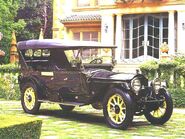Search By Model |
| Defunct |
Packard was a United States based brand of luxury automobile built by the Packard Motors Company of Detroit, Michigan, and later by the Studebaker-Packard Corporation of South Bend, Indiana. The first Packard automobiles were produced in 1899 and the brand went off the market in 1958. Packard automobiles are highly sought after by collectors today, and the marque enjoys an active collectors club system.
Packards were advertised with the slogan "Ask the Man Who Owns One".
History
1899 - 1929
Packard was founded by brothers James Ward Packard (Lehigh University Class of 1884) and William Dowd Packard in the city of Warren, Ohio . The Packards believed that they could build a better automobile and James, a mechanical engineer, had some ideas how to improve on the designs of current automobiles. By 1899, the brothers were building vehicles in their native Warren, Ohio. The company, which they called the Ohio Automobile Company, quickly introduced a number of innovations in its designs, including the modern steering wheel and the first production 12-cylinder engine.
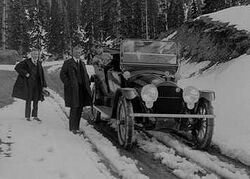
1913 Packard 6
While Henry Ford was producing cars that sold for $440, the Packards concentrated on more upscale cars that started at $2,600. Packard automobiles developed a following not only in the United States, but also abroad, with many heads of state owning them.
In need of more capital, the Packard brothers would find it when Henry Bourne Joy, a member of one of Detroit's oldest and wealthiest families, bought a Packard. Impressed by its reliability, he visited the Packards and soon enlisted a group of investors that included his brother-in-law, Truman Handy Newberry. On October 2, 1902, Ohio Automobile Company became Packard Motor Car Company, with James as president. Packard moved its automobile operation to Detroit soon after and Joy became general manager and later chairman of the board. And one of if not the original packards is still located at the packard museum in Warren, Ohio on mahoning ave.
The Packard's factory on East Grand Boulevard in Detroit was designed by Albert Kahn, and included the first use of reinforced concrete for industrial construction in Detroit. When opened, it was considered the most modern automobile manufacturing facility in the world and its skilled craftsmen practiced over eighty trades.
The 3.5 million ft2 (325,000 m²) plant covered over 35 acres (142,000 m²) and straddled East Grand Boulevard. It was later subdivided by eighty-seven different companies. Kahn also designed The Packard Proving Grounds at Utica, Michigan.
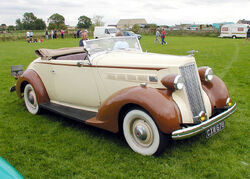
Packard 120 car of 1936

1937 Packard

1941 Packard 180 Formal Sedan
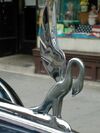
Packard Pelican hood ornament from a 1941 180 Formal Sedan
Throughout the nineteen-teens and twenties, Packard built vehicles consistently were among the elite in luxury automobiles. The company was commonly referred to as being one of the three "P's" of American motordom royalty, along with Pierce-Arrow of Buffalo, New York and Peerless of Cleveland, Ohio. Packard's cachet was so strong that its production was quickly placed ahead of General Motors Cadillac automobiles.
1930 - 1946
Entering into the 1930s Packard attempted to ride out the stock market crash and subsequent depression by manufacturing slightly less expensive cars than it had prior to October 1929. As an independent automaker, Packard did not have the luxury of a larger corporate structure absorbing its losses as Cadillac did with GM and Lincoln with Ford. However Packard did have a better cash position than other independent luxury marques. Peerless fell under receivership in 1929; by 1940 Marmon, Ruxton , Stearns-Knight, Duesenberg and Pierce-Arrow all closed.
Packard also had one other advantage that some other luxury automakers did not; a single production line. By maintaining a single line, and inter-changeability between models, Packard was able to keep its costs down. Packard did not change cars as often as other manufacturers did at the time. Rather then introduce new models annually, Packard began using its own Series formula for differentiating its model change-overs in 1913. By 1930, Packard automobiles were considered part of the "Seventh Series". By 1942, Packard was in its Twentieth Series.
To address the depression, Packard started producing affordable cars in the upper middle-price range. In 1935, it introduced its first sub-$1,000 car, the Packard 120. Car production tripled that year and doubled again in 1936.
1937 – 1942
Between 1937 and 1945, three decisions were made by Packard that would haunt the company for the remainder of its existence.
Prior to 1937, Packard was still the premier luxury automobile, even though the lion's share of cars being built were the 120 and Super Eight model ranges. Hoping to catch more of the market, Packard decided issue the Packard 115C in 1937, which was powered by Packard's first six cylinder since the Fifth Series cars in 1927. While the move to introduce the Six was at once brilliant – the car arrived just in time for the 1938 recession – it was also tagged Packard's as something less exclusive than it had been in the public's mind, and in the long run the Six hurt Packard's reputation of building some of America's finest luxury cars. The Six, designated "110" in 1940-41, continued for three years after the war.
The second decision that the company made was to invest in modernizing their car design in time for the United States entry into World War. Afraid that changing the traditional Packard too much would drive its valued clientele away, the company issued the sleek Packard Clipper in mid-1941 as a single model and expanded the design to four price ranged for 1942. Whatever benefit the Clipper could have provided Packard was negated by the conversion to military production and the end of consumer car sales for the duration of the war. Had Packard held onto the Clipper design until after the War, it could have been the first automobile company with a new post-war design.
The third decision that would hurt Packard and its reputation was installation of a second assembly line and the costs associated with it. Prior to the war, Packard's single line worked in favor of the economy of Packard relatively low production and expenses. But with the second line, labor costs increased as production began to ramp up on mid-priced cars, which further devalued Packard's cachet.
During World War II, Packard again built airplane engines, licensing the Merlin engine from Rolls-Royce, and simplifying and improving upon it. The Packard engine powered the famous P-51 Mustang fighter, known as the "Cadillac of the Skies" by G.I.s in WWII. It was one of the fastest non-jet fighter planes ever built, and could fly higher than any of its contemporaries, allowing its pilots a greater degree of survivability in combat situations. They also built 1350, 1400, and 1500 hp V-12 marine engines that powered American PT boats (each boat used three) and some of Britain's patrol boats.
1946 – 1956
By the end of World War II, Packard was in excellent financial condition but suffered from a shortage of raw materials needed to manufacture automobiles again. The firm introduced its first post-war body in 1948, prior to its competition in the major firms (Cadillac, Lincoln, and Chrysler). However, the design chosen was of the "bathtub" style predicted during the war as the destined future of automobiles. The postwar Packards sold poorly, and the ability to distinguish expensive models from lower priced models disappeared as all Packard became virtually alike.
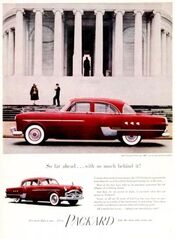
Ad for the 1951 Packard Patrician
By the time the firm was able to re-style again for 1951, the post war seller's market was coming to an end and again, the design failed to resonate with the public at large. Conceived as the antithesis of the bulbous post war models, the motoring press derisively named the new design "high pockets".
Packard President James Nance was also struggling with what he felt was the only way to reestablish Packard as a luxury car brand, which was to divorce the lower priced models from the luxury models. To do this Nance applied the model name Clipper to the least expensive Packards. Ultimately Nance planned to spin Clipper off as its own automotive brand targeting Oldsmobile and Mercury, while a target date of 1956 was set for the new automotive brand.
Nash Motors president George Mason approached Packard about a merger for the first time in the late 1940s, believing that the days for independent car manufacturers were numbered. Packard's board of directors, believing Mason to be incorrect, was reluctant to merge. 1953 brought the return of the buyer's market, and 1954 was again a down year for Packard; still, Packard's directors delayed.
Meanwhile, Mason found a more receptive audience at Hudson, and the two companies merged to form American Motors Corporation on May 1, 1954. This left Packard, whose directors had finally seen the light, seeking a merger partner. After briefly considering joining the merged Kaiser-Willys organization (which was formed solely to take the two struggling firms out of the U.S. auto business in order to concentrate on Jeeps), and seeing no possibilities there, Packard's directors settled on Studebaker.
On October 1, 1954, Packard merged with Studebaker creating the Studebaker-Packard Corporation. Initially, Packard's executive team had hoped Studebaker's larger network of dealers would help increase sales. At first Nance believed that Studebaker's volume could sustain the companies, however Nance and other Packard officials discovered that Studebaker's finances were more dire than previously believed, primarily because no one took the time to actually study them in depth prior to the merger.
Packard's up-again and down-again sales continued, with a profitable year in 1955 thanks to the introduction of Packard's first V-8 engines that model year—although a complete retooling for the 1955 models resulted in products so poorly made that hundreds of cars had to be repaired by dealers before they could be sold to the public. This set the stage for a disastrous 1956, which saw production drop to its lowest levels since World War I.
1956 saw the launch of Clipper as a stand alone marque and as well as the launch of the Packard Executive, Packard's new entry level car priced to compete against Chrysler and Buick. However Packard dealers began to complain that consumers weren't buying Clippers because the cars weren't Packards. At first Nance refused to rebadge the Clipper as a Packard, but the dealers pushed back. In the end, Nance begrudgingly agreed to start badging the cars as "Clipper, by Packard."
Packard had been selling engines and transmissions to American Motors, but a parts dispute with Romney ended this arrangement in April of 1956. The company severely in debt, its creditors ordered the old Packard plants to close on August 15, 1956, and Nance left the company which then entered into a contractual management agreement with aircraft maker Curtiss-Wright.
1957 – 1958: Packardbakers
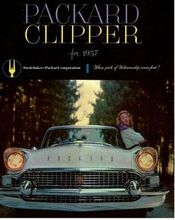
1957 Packard Clipper sales brochure
In 1957 and 1958, a Studebaker-based car bearing the Packard Clipper nameplate appeared on the market, but sales were slow. These badge engineered Studebakers were derisively referred to as Packardbakers by the press and consumers and failed to sell in sufficient numbers to keep the marque afloat.
While the 1957 Packard Clipper was less Packard than it was a very good Studebaker, the cars sold in limited numbers – which was attributed to Packard dealers dropping the franchises and consumers fearful of buying a car that could be an orphaned make soon.
The 1958 models bowed with no series name, simply as "Packard". In addition to the knowledge that these cars were the last gasp by what had been thirty years before the biggest selling luxury car in the United States, their annual make-over on a budget usually set aside for a door-handle design at GM was awkward.
The end
Studebaker pulled the Packard nameplate from the marketplace in 1959 to focus instead on its compact Lark.
In the Early 1960s, Studebaker-Packard was approached by French car maker Facel-Vega about the possibility rebadging the company's Facel-Vega Excellence sedan as a "Packard" for sale in North America. Daimler-Benz, which was under a distribution agreement with Studebaker-Packard, threatened to pull out of the 1958 marketing agreement, which would have cost Studebaker-Packard more in revenue than they could have made from the badge-engineered Packard.
Packard engines
Packard had an engineering staff that always designed good, well-made engines. This was doubled into their twelve-cylinder engine that they called the "Twin Six." They also built a low-compression straight eight, but never a sixteen-cylinder engine. After WWII, they were one of the last US firms to produce a high-compression V-8 engines, the "352", named for its 352 in³ (5.8 L) displacement, but it had no problems. However, they built their own automatic transmission (unlike Ford) which, although it had some advantages over Buick's, had its own deficiencies. Their last major development was the "Torsion-Level" suspension, a four-wheel torsion-bar suspension that balanced the car's height like an air-bag suspension, which its American competitors of the time could not get to work and ceased offering.
Modern Packard
A new company bearing the Packard name was started up soon after 2000 and produced at least one prototype Packard. The prototype was shown at the Pebble Beach Concours d'Elegance in 2003.
Packard automobile models
- Packard 110
- Packard 120
- Packard 180
- Packard 200
- Packard 250, see Packard 200
- Packard 300
- Packard 400, see Packard Four Hundred
- Packard Caribbean
- Packard Cavalier
- Packard Clipper
- Packard Eight
- Packard Executive
- Packard Four Hundred
- Packard Hawk (1958)
- Packard Mayfair
- Packard Patrician
- Packard Patrician 400, see Packard Patrician
- Packard Six
- Packard Station Sedan
- Packard Twin Six/Twelve
- 1957 and 1958 Packards
Body styles/misc. by tradename
- Packard Clipper Constellation
- Packard Super Panama
- Ultramatic, Packard's self-developed automatic transmission (1949-1956)
Photos
See also
| image (between 170-190 pixels) | ||
| PACKARD | ||
|
Studebaker-Packard Corporation Clipper | Packard | Studebaker | Ultramatic Models 200 · 300 · Caribbean · Cavalier · Clipper · Clipper Constellation · Eight · Light Eight · Super Eight · Executive · Four Hundred · Hawk · One-Eighty · One-Ten · One-Twenty · Patrician · Packard Six · Twin Six/Twelve · Station Sedan · Studebaker based Packards Concept Models Balboa-X · Pan American · Panther · Predictor · Request · Special Speedster One-Off Customs Brown Bomber · El Paso · Pacifica · Parisian · Howard Darrin · James J. Nance · James Ward Packard · William Dowd Packard · George T. Christopher · Hugh Ferry · Alvan Macauley · Edward Macauley · Jesse Vincent · Richard Teague · John Reinhart | ||
| James Ward Packard and William Dowd Packard | None; Defunct | A division of the Studebaker-Packard Corporation |
Clients
- Toronto Transportation Commission

